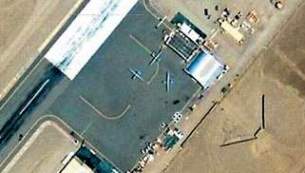|
Google Earth reveals secret CIA drone base in Pakistan
by Jeremy Page via rialator - The Times Thursday, Feb 19 2009, 8:33pm
international /
imperialism /
other press
The US was secretly flying unmanned drones from the Shamsi airbase in Pakistan's southwestern province of Baluchistan as early as 2006, according to an image of the base from Google Earth.

The image — that is no longer on the site but which was obtained by The News, Pakistan's English language daily newspaper — shows what appear to be three Predator drones outside a hangar at the end of the runway. The Times also obtained a copy of the image, whose co-ordinates confirm that it is the Shamsi airfield, also known as Bandari, about 200 miles southwest of the Pakistani city of Quetta.
An investigation by The Times yesterday revealed that the CIA was secretly using Shamsi to launch the Predator drones that observe and attack al-Qaeda and Taleban militants around Pakistan's border with Afghanistan.
US special forces used the airbase during the invasion of Afghanistan in 2001, but the Pakistani Government said in 2006 that the Americans had left. Both sides have since denied repeatedly that Washington has used, or is using, Pakistani bases to launch drones. Pakistan has also demanded that the US cease drone attacks on its tribal area, which have increased over the last year, allegedly killing several “high-value” targets as well as many civilians.
The Google Earth image now suggests that the US began launching Predators from Shamsi — built by Arab sheiks for falconry trips — at least three years ago.
The advantage of Shamsi is that it provides a discreet launchpad within minutes of Quetta — a known Taleban staging post — as well as Taleban infiltration routes into Afghanistan and potential militant targets farther afield.
Google Earth's current image of Shamsi — about 100 miles south of the Afghan border and 100 miles east of the Iranian one — undoubtedly shows the same airstrip as the image from 2006.
There are no visible drones, but it does show that several new buildings and other structures have been erected since 2006, including what appears to be a hangar large enough to fit three drones. Perimeter defences — apparently made from the same blast-proof barriers used at US and Nato bases in Afghanistan — have also been set up around the hangar.
A compound on the other side of the runway appears to have sufficient housing for several dozen people, as well as neatly tended lawns. Three military aviation experts shown the image said that the aircraft appeared to be MQ1 Predator unmanned aerial vehicles — the model used by the CIA to observe and strike militants on the Afghan border.
The MQ1 Predator carries two laser-guided Hellfire missiles, and can fly for up to 454 miles, at speed of up to 135mph, and at altitudes of up to 25,000ft, according to the US Air Force website www.af.mil
The News reported that the drones were Global Hawks — which are generally used only for reconnaissance, flying for up to 36 hours, at more than 400mph and an altitude of up to 60,000ft. Damian Kemp, an aviation editor with Jane's Defence Weekly, said that the three drones in the image appeared to have wingspans of 48-50ft.
“The wingspan of an MQ1 Predator A model is 55ft. On this basis it is possible that these are Predator-As,” he said. “They are certainly not RQ-4A Global Hawks (which have a wingspan of 116ft 2in).”
Pakistan's only drones are Italian Galileo Falcos, which were delivered in 2007, according to a report in last month's Jane's World Air Forces.
A military spokesman at the US Embassy in Islamabad declined to comment on the images — or the revelations in The Times yesterday.
Major-General Athar Abbas, Pakistan's chief military spokesman, was not immediately available for comment. He admitted on Tuesday that US forces were using Shamsi, but only for logistics.
He also said that the Americans were using another air base in the city of Jacobabad for logistics and military operations. Pakistan gave the US permission to use Shamsi, Jacobabad and two other bases — Pasni and Dalbadin — for the invasion of Afghanistan in October 2001.
The image of the US drones at Shamsi highlights the extraordinary power — and potential security risks — of Google Earth.
Several governments have asked it to remove or blur images of sensitive locations such as military bases, nuclear reactors and government buildings. Some have also accused the company of helping terrorists, as in 2007, when its images of British military bases were found in the homes of Iraqi insurgents.
Last year India said that the militants who attacked Mumbai in November had used Google Earth to familiarise themselves with their targets. Google Street View, which offers ground-level, 360-degree views, also ran into controversy last year when the Pentagon asked it to remove some online images of military bases in America.
© 2009 Times Newspapers Ltd
http://www.timesonline.co.uk/tol/news/world/asia/article5762371.ece
<< back to stories
|